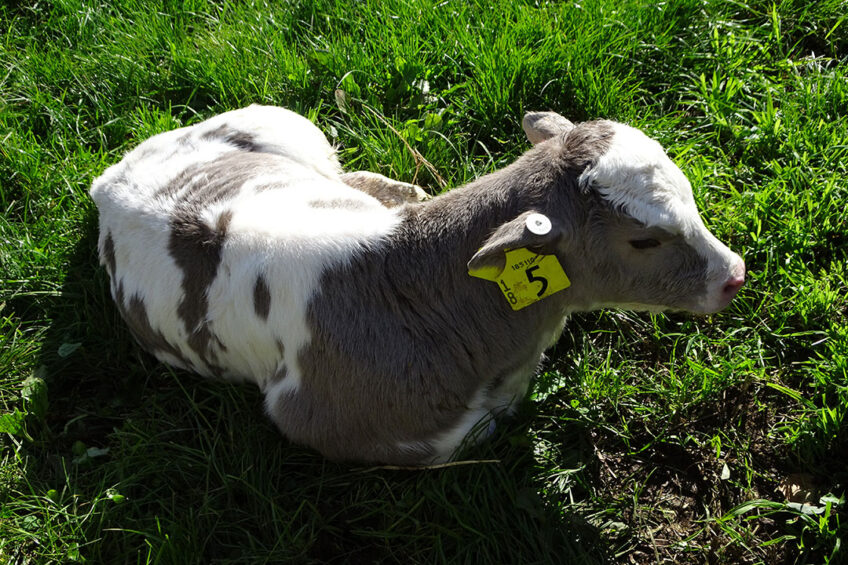Gene editing for improved heat tolerance in dairy cows

In some parts of the world, average summer temperatures and the number of ‘extreme heat days’ are increasing. Dairy cattle out on pasture are therefore subject to more heat stress. Smaller cow breeds like the Guernsey fare better than large ones such as the Holstein, but the coat type and colour also plays a role.
There are so far 2 avenues the coat can be changed through gene editing to increase heat tolerance. First a look at the so-called ‘slick coat,’ which involves hair that’s short and sleek and sometimes even glossy.
Slick coat trait
Holsteins with the slick coat have shown better heat tolerance in that, for example, they have lower internal (vaginal) temperatures and a lower respiration rate. In 2020, researchers at Mississippi State University and University of Puerto Rico at Mayagüez published a paper also concluding that under the hot and humid conditions of Puerto Rico, Holstein cows with the slick gene perform better reproductively than those without it.
The slick trait involves a single dominant gene, which makes it very suitable for gene editing compared to traits that involve many genes. Gene edits involve, according to Dr Alison Van Eenennaam, a geneticist at University of California, Davis, guiding enzyme ‘scissors’ to do a targeted, specific cut in a DNA sequence. “Depending on how that’s repaired, you can have inactivation of the gene that’s located at that point on the strand, or a difference in how the gene functions,” she explains. “There can also be DNA introduced from that organism or another of its species, or from another species.” Van Eenennaam has used gene editing to create a bull calf that would produce more than 50% male offspring.
Geneticists at the Roslin Institute (University of Edinburgh in Scotland) have used gene-editing to introduce the ‘slick coat gene’ into newly-fertilised eggs from cows without the gene. Modified embryos were transferred into surrogate mother cows and calves were born with slick coats (and no other differences).
The team has noted that using this gene edit has great potential to build up the cow populations better adapted to heat stress around the world, and that it would be especially useful in assisting small-holders in tropical countries. They are now working with colleagues at the International Livestock Research Institute in Kenya with native cattle breeds there.
Team member Dr Appolinaire Djikeng has stated that “with gene editing, we can do small edits in the genome that very rapidly accomplish improvements that would otherwise take 20 generations. I am very excited about the potential adoption of this technology in Kenya, the UK and other places around the world.”
Another slick gene edit project
Meanwhile, a US firm called Recombinetics has used gene editing to produce 2 beef calves with the slick coat trait. In March 2022, the US Federal Drug Administration (FDA) gave its first decision on gene-edited livestock relating to this gene edit, an ‘enforcement discretion ruling.’ This means these calves are excused from the enforcement of existing US gene editing regulations because the FDA determined that the ‘risk’ associated with these calves and their gene edit was low. Currently the FDA classifies any genetic alteration to an animal through gene editing as a new animal drug and US regulatory frameworks for drugs therefore apply. In future, gene-edited animals in the US could be regulated by the US Department of Agriculture instead of FDA, which already regulates gene edits to plants involving inactivation of a gene or any gene that could have been introduced through conventional breeding.
Van Eenennaam surmises that “the FDA could look at a tiered system with levels of risk. And it should be soon. We have to remember there are huge costs to delaying gene editing research and commercialisation.”
Other countries such as Brazil, Australia and Argentina view gene editing like normal breeding in situations where a gene is knocked out and no novel DNA is introduced.
Dr Tad Sonstegard, President and CEO at Acceligen (owned by Recombinetics) says they will continue to work towards US commercialisation of cows with the slick gene edit.
Black coat, more heat
Another way gene editing is being used to reduce heat stress in cattle is through changing the coat colour. The Holstein cow has a black and white coat, with some of the breed having a lot of black, unlike other light-coloured dairy breeds such as Jersey – and dark colours absorb significantly more UV rays than lighter.
A team of geneticists have already accomplished this with Holsteins in New Zealand, using a gene edit to eradicate the black coat hairs. The team is based at the AgResearch, Ruakura Research Centre, University of Auckland, Auckland, Maurice Wilkins Centre for Molecular Biodiscovery, Massey University Manawatu and the Livestock Improvement Corporation.
In their paper, they explain that they introduced a deletion in Holsteins in “the pre-melanosomal protein 17 gene proposed as causative variant for the semi-dominant colour dilution phenotype observed in Galloway and Highland cattle. Calves generated from cells with homozygous edits displayed a novel grey and white coat pattern.”
They add that “although we have demonstrated it for a dairy breed, the strategy could be readily applied to beef breeds such as Black Angus. Overall, our study exemplified and validated genome editing as a promising new approach for the rapid adaptation of livestock to changing environmental conditions.”
Other heat-related genes
Meanwhile in Australia, scientists at Agriculture Victoria in the state of Victoria, Australia have identified several genes strongly associated with heat tolerance.
Australia has had genomic breeding values for heat tolerance available for dairy farmers since 2017 through DataGene, an independent organisation run by Dairy Australia and the country’s dairy industry.
References are available on request.







